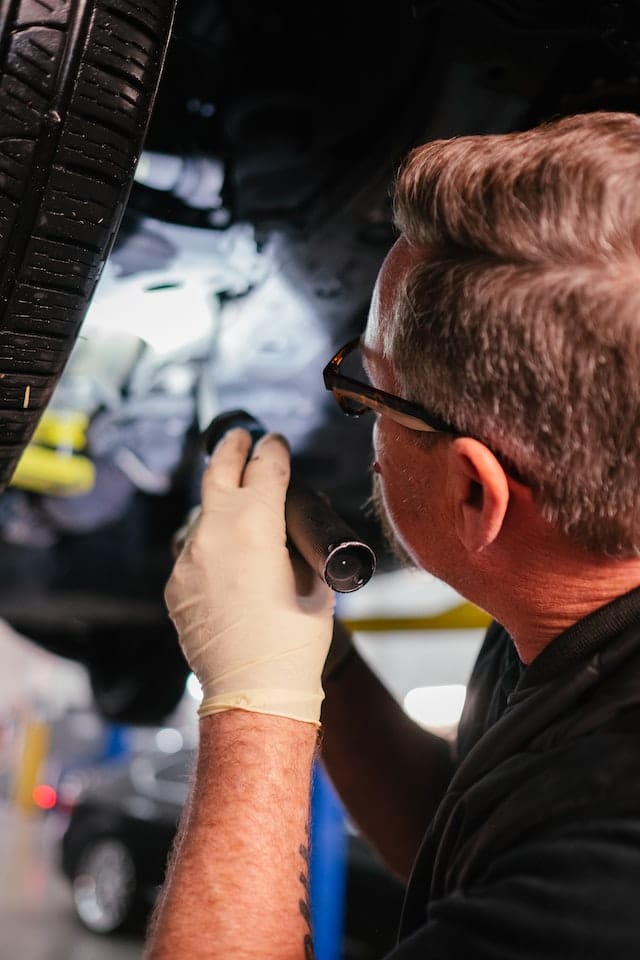Does your car feel bumpy when driving? A smooth ride is a good indicator of a well-maintained vehicle. If your vehicle starts to feel bumpy, it’s likely signaling an issue that needs attention. Here, we have shared 8 tips to address this problem.
Handling a Bumpy Car Ride: 8 Easy Tips
1. Check Tire Pressure & Inspect Your Tires
Incorrect tire pressure can cause a bumpy ride. Keep a tire pressure gauge handy in your vehicle. Uneven tire wear can also make the car feel bumpy. Inspect your tires for uneven wear patterns. Rotate them regularly to maintain even wear.
2. Balance Your Tires
Imbalanced tires create an uneven driving experience. Have your tires professionally balanced at a local tire shop. Do this every time you buy new tires.
3. Replace Old Tires
Old or worn tires can also cause bumpiness. Check the tread depth. If it’s below 2/32 inch, replace your tires.
4. Maintain Suspension Components
A worn-out suspension can lead to a bumpy ride. Regularly check and replace suspension components such as shock absorbers and struts.
Check your car’s suspension by observing if it leans or bounces excessively and by listening for unusual noises when driving over bumps. Leaning, continued bouncing after bumps, and clunking or squeaking sounds may all indicate worn suspension components.
5. Monitor Your Drivetrain
A problematic drivetrain can lead to a bumpy driving experience. Look out for intense shaking during acceleration. If it occurs, have your driveline inspected.
6. Inspect Engine Mounts
Damaged engine mounts can lead to increased vibration. If you feel excess vibration, get your engine mounts checked and replaced if necessary.
7. Check Brake System
Problems in the brake system can cause vibrations. When braking, pay attention to unusual noises, changes in pedal feel, and the car’s overall response. Noises can indicate worn pads, a spongy pedal might signal fluid problems, and the car pulling to one side could suggest uneven pad wear or fluid issues.
8. Mind Your Vehicle’s Weight Load
Overloading your vehicle can strain its suspension. It can cause a bumpy ride too. Always stay within your vehicle’s recommended weight limit.
If these tips don’t help, it’s a good idea to have your car checked by a professional, as there may be a more complex issue at hand. For more detailed information about fixing a bumpy car ride, see the sections below.
Possible Causes of Bumpy Driving
Experiencing a bumpy ride when you’re driving can be uncomfortable, and more importantly, could signal underlying issues with your car. If your car feels bumpy when driving, there are several potential causes ranging from worn or damaged tires, suspension system issues, wheel alignment problems, brake problems, to engine issues. Each of these problems not only affects your driving comfort but also your safety and the lifespan of your vehicle. In this article, we will delve into each of these causes, explaining how they can lead to a bumpy ride, and offer solutions to rectify these issues, helping you restore a smooth and safe driving experience.

The following are the most common causes of bumpy driving:
Worn or Damaged Tires
Tires that are old or damaged can cause the car to feel bumpy while driving. A tire’s tread can wear unevenly over time, creating bumps and ridges that can be felt by the driver.
Suspension System Issues
The suspension system of a car helps to absorb shocks and vibrations from the road. When the suspension system is damaged or worn, it can cause the car to feel bumpy when driving.
Wheel Alignment Problems
Wheel alignment issues can cause the car to pull to one side and create a bumpy ride. When the wheels are not properly aligned, the car can also wear tires unevenly, causing bumps and vibrations.
Brake Problems
Brakes that are worn, warped, or damaged can cause the car to vibrate and feel bumpy when driving. It’s important to have the brake system checked regularly to avoid potential safety hazards.
Engine Issues
Engine problems such as misfiring or poor acceleration can also cause the car to feel bumpy when driving. In some cases, the engine’s mounts may also be damaged, causing vibrations throughout the car.
[lasso id=”5401″ link_id=”1571″ ref=”amzn-noco-boost-plus-gb40-1000a-ultrasafe-car-battery-jump-starter-12v-battery-pack-battery-booster-jump-box-portable-charger-and-jumper-cables-for-6-0l-gasoline-and-3-0l-diesel-engines-gray” sitestripe=”true”]How to Diagnose the Problem

Here are some steps to diagnose the issue:
Visual Inspection of Tires and Suspension System
Check the tires for signs of wear, damage, or uneven tread. Inspect the suspension system for damage, wear, or leaks.
Testing the Shocks and Struts
A mechanic can test the shocks and struts to see if they are functioning properly.
Checking Wheel Alignment
A wheel alignment check can reveal any alignment issues that may be causing the bumpy ride.
Brake Inspection
Have a mechanic inspect the brakes for any wear, damage, or warping.
Engine Diagnostics
An engine diagnostic check can identify any issues with the engine or engine mounts.
Car Feels Bumpy When Driving: How to Fix the Problem
Depending on the cause of the problem, there are several solutions available:
Replacing Worn or Damaged Tires
Replace any tires that are worn, damaged, or have uneven tread.
Replacing or Repairing Suspension System Components
Repair or replace any damaged or worn suspension system components.
Adjusting Wheel Alignment
Have the wheels properly aligned to correct any alignment issues.
Repairing or Replacing Brakes
Replace worn or damaged brakes to ensure safe and smooth driving.
Addressing Engine Issues
Have the engine checked and repaired by a professional mechanic.
Preventing Bumpy Driving in the Future
To prevent bumpy driving in the future, it’s important to practice regular vehicle maintenance, including:
Proper Tire Inflation and Rotation
Keep your tires properly inflated and rotate them regularly to ensure even wear.
Avoiding Potholes and Other Road Hazards
Avoid hitting potholes and other road hazards that can damage the tires and suspension system.
Safe Driving Habits
Drive safely and avoid sudden stops, jerky movements, and excessive speed.
FAQs: Car Feels Bumpy When Driving

Q: Why does my car feel bumpy when I drive?
A: There could be several reasons for this, including worn or damaged tires, issues with the suspension system, problems with wheel alignment, brake problems, or engine issues.
Q: Can worn tires cause a bumpy ride?
A: Yes, tires that are old or damaged can wear unevenly, creating bumps and ridges that can cause a car to feel bumpy while driving.
Q: What suspension system issues can cause a bumpy drive?
A: Any damage or wear to the suspension system can lead to a bumpy drive as it can no longer effectively absorb shocks and vibrations from the road.
Q: How does wheel alignment affect the smoothness of my drive?
A: If your wheels are not properly aligned, your car may pull to one side and cause a bumpy ride. It can also lead to uneven tire wear, adding to the problem.
Q: Can brake problems cause my car to feel bumpy when driving?
A: Yes, worn, warped, or damaged brakes can cause your car to vibrate and feel bumpy when driving. Worn brake pads can reduce the effectiveness of your braking, leading to shuddering. Warped rotors can cause vibrations felt through the steering wheel. Damaged calipers can create an uneven pressure distribution, adding to the bumpy feel. These issues not only make driving uncomfortable but can also compromise your vehicle’s safety.
Q: What causes my brakes to have a bumpy or uneven feel when applied?
A: A bumpy sensation when using brakes can result from warped brake rotors, uneven brake pad wear, or debris between the brake pad and rotor.
Q: Can engine issues lead to a bumpy ride?
A: Yes, engine problems such as misfiring or poor acceleration can cause your car to feel bumpy. In some cases, damaged engine mounts may also lead to vibrations throughout the car.
Q: How can I fix the problem if my car feels bumpy when driving?
A: The solution depends on the root cause. It may be as simple as replacing worn tires or as complex as repairing engine issues. Regular maintenance checks and timely repairs are essential for a smooth and safe ride.
Q: How much does it typically cost to replace worn or damaged tires?
A: The cost to replace a single tire can range from $50 to $250 for a standard passenger vehicle, depending on the brand and type of tire. Keep in mind that for balanced handling, it’s usually recommended to replace tires in pairs or sets.
Q: What does it cost to fix suspension system issues?
A: The cost of suspension repair can vary widely based on the exact problem and the make and model of your vehicle. On average, you might expect to pay between $250 and $1500.
Q: How much does it cost to correct wheel alignment problems?
A: A basic wheel alignment (also known as a tire alignment) can typically cost between $50 and $100. More complex adjustments, like a four-wheel alignment, can cost between $100 and $200.
Q: What is the estimated cost for fixing brake problems?
A: Repair costs can vary greatly depending on what’s wrong with the braking system. A simple brake pad replacement can cost anywhere from $100 to $300 per axle, while more complex repairs like replacing a master cylinder can range from $200 to $400.
Q: What might it cost to repair engine issues causing a bumpy ride?
A: Engine repairs can vary dramatically in cost depending on the specific issue. Minor repairs might only cost a few hundred dollars, while major repairs or engine replacements can cost several thousand dollars.
Q: Are there any DIY solutions for a bumpy ride?
A: Some issues, such as tire replacement or simple brake repairs, might be manageable as DIY tasks if you have some mechanical knowledge. However, more complex issues, especially those involving the engine or suspension, typically require professional attention due to the specialized tools and knowledge required.
Q: Is it safe to drive my car if it feels bumpy?
A: If your car is feeling bumpy, it’s a sign that something may be wrong. While it might not cause an immediate danger, it could potentially lead to more serious problems down the line. It’s best to have your car inspected by a professional to ensure safety.
Q: Why does my car feel bumpy or unstable at high speeds?
A: A car feeling bumpy at high speeds can be due to several factors. Common causes include unbalanced or damaged tires, worn-out suspension components, bent wheels, or misaligned wheels. It’s crucial to address these issues early, both for safety and the longevity of the vehicle. Regular inspections and maintenance can help identify and correct these problems.
Q: Why does my car feel bumpy or uneven when driving at slower speeds?
A: Experiencing a bumpy ride at slow speeds can be attributed to various reasons, including damaged shock absorbers, unbalanced tires, issues with the tire treads, or problems with the suspension system. It’s recommended to inspect these components for wear or damage to pinpoint and resolve the underlying issue.
Q: Why Does My Car Feel Bumpy Even on a Smooth Road?
A: If your car feels bumpy despite driving on a smooth road, several issues could be the cause. Worn or unbalanced tires are common culprits that disrupt smooth driving. Suspension problems, like worn-out shocks or struts, can also make your ride less comfortable. Issues with the wheel alignment can contribute to an unstable feeling, as can problems with the car’s bushings or control arms. In some cases, a bent wheel or axle can also make for a bumpy ride. Lastly, internal issues like a failing transmission or imbalanced drivetrain could be responsible. If you’re experiencing a consistently bumpy ride, it’s advisable to get your vehicle inspected for a proper diagnosis and remedy.


